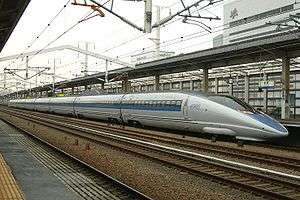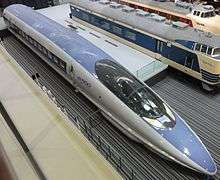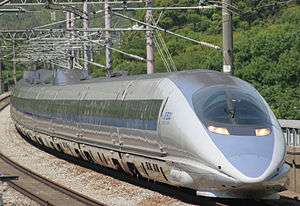500 Series Shinkansen
| 500 series | |
|---|---|
|
16-car 500 series on Nozomi service, May 2008 | |
| In service | 1997–present |
| Manufacturer | Hitachi, Kawasaki Heavy Industries Rolling Stock Company, Kinki Sharyo, Nippon Sharyo |
| Replaced | 0 series |
| Constructed | 1995–1998 |
| Refurbishment | 2008-2010 |
| Number built | 144 vehicles (9 sets) |
| Number in service | 64 vehicles (8 sets) |
| Number preserved | 1 vehicle |
| Number scrapped | 79 vehicles |
| Formation | 8 (originally 16) cars per trainset |
| Fleet numbers | V2–V9 |
| Capacity |
16-car W set: 1,324 (200 Green + 1,124 Standard) 8-car V set: 608 |
| Operator(s) | JR-West |
| Depot(s) | Hakata |
| Line(s) served | Sanyo Shinkansen, Hakata-Minami Line |
| Specifications | |
| Car body construction | Aluminium alloy |
| Car length | 25,000 mm (82 ft 0 in) (intermediate cars), 27,000 mm (88 ft 7 in) (end cars) |
| Width | 3,380 mm (11 ft 1 in) |
| Height | 3,690 mm (12 ft 1 in) |
| Maximum speed |
W set: 300 km/h (186 mph) (Sanyō) V set: 285 km/h (177 mph) Design speed: 320 km/h (199 mph) |
| Traction system | (AC) WMT204 64 x 285 kW (382 hp) (set W1)/275 kW (369 hp) (set W2 onward)[1] |
| Power output | 18.24 MW (24,460 hp) (set W1), 17.60 MW (23,600 hp) (set W2 onward) |
| Acceleration |
1.6 km/h/s (0.44 m·s−2) [2] 1.92 km/h/s (0.53 m·s−2) (High acceleration mode)[2] |
| Deceleration | 2.7 km/h/s (0.75 m·s−2) |
| Electric system(s) | 25 kV AC, 60 Hz overhead catenary |
| Current collection method |
W set: "T"-style current collector V set: Pantograph |
| Safety system(s) | ATC-1, ATC-NS |
| Track gauge | 1,435 mm (4 ft 8 1⁄2 in) |
The 500 series (500系 Gohyaku-kei) is a Shinkansen high-speed train type operated by West Japan Railway Company (JR-West) on the Tokaido Shinkansen and Sanyo Shinkansen lines in Japan.[3] They were designed to be capable of 320 km/h (200 mph) but operated at 300 km/h (185 mph), until they were finally retired from the primary Nozomi service in 2010. The trainsets were then refurbished and downgraded to the all-stations Kodama service between Shin-Osaka and Hakata.
Overview
The general design concept was overseen by German industrial designer Alexander Neumeister.[4] The running gear utilizes computer-controlled active suspension[5] for a smoother, safer ride, and yaw dampers are fitted between cars for improved stability. All sixteen cars in each original trainset were powered, giving a maximum of 18.24 MW (24,460 hp). Each train cost an estimated 5 billion yen, and only nine were built.
16-car W sets
First announced by JR-West in September 1994,[6] the first set was delivered for testing in 1995, entering passenger service in March 1997. The entire fleet of nine sets was delivered by 1998. It was the first Shinkansen train in Japan to operate at a maximum speed of 300 km/h (185 mph) in regular passenger service. Besides the premium Nozomi services, 16-car trains were also used on Hikari Rail Star services during the busy holiday periods.
With the steady increase in the number of N700 Series Shinkansen since 2007, the 500 series were gradually retired from the Nozomi services. The last 500 series Nozomi run took place on 28 February 2010.[7]
Formation
| Car No. | 1 | 2 | 3 | 4 | 5 | 6 | 7 | 8 | 9 | 10 | 11 | 12 | 13 | 14 | 15 | 16 |
|---|---|---|---|---|---|---|---|---|---|---|---|---|---|---|---|---|
| Designation | Mc | M1 | Mp | M2 | M' | M1 | Mp | Ms2 | Ms | M1s | Mpkh | M2 | M' | M1 | Mp | M2c |
| Numbering | 521-xx | 526-xx | 527-xx | 528-xx | 525-xx | 526-xx | 527-4xx | 518-xx | 515-xx | 516-xx | 527-7xx | 528-7xx | 525-xx | 526-xx | 527-xx | 522-xx |
| Seating capacity | 53 | 100 | 90 | 100 | 95 | 100 | 75 | 68 | 64 | 68 | 63 | 100 | 95 | 100 | 90 | 63 |
Cars 8 to 10 were "Green" (first class) cars. Cars 5 and 13 each had one "T"-style current collector.[8]
Interior
-

Standard-class car interior view
-
Standard-class seating
-
Green car seating
8-car V sets (500-7000 series)

Eight of the original nine 500 series sets were modified and shortened to 8 cars between 2008 and 2010, and were cascaded to Sanyo Shinkansen Kodama workings, replacing the earlier 0 series sets.[9] The first reformed 8-car set was unveiled to the press on 28 March 2008, and the trains entered service on twelve daily Kodama runs from 1 December 2008.[10]
The maximum operating speed of these trains has been reduced to 285 km/h (177 mph).[11]
Formation
As of 1 April 2016, the fleet consists of eight 8-car sets (V2 to V9) formed as follows, with car 1 at the Hakata end.[12]
| Car No. | 1 | 2 | 3 | 4 | 5 | 6 | 7 | 8 |
|---|---|---|---|---|---|---|---|---|
| Designation | Mc | M1 | Mp | M2 | M | M1 | Mpkh | M2c |
| Numbering | 521-70xx | 526-70xx | 527-70xx | 528-70xx | 525-70xx | 526-72xx | 527-77xx | 522-70xx |
| Formerly | 521 (car 1) | 526 (car 2) | 527 (car 3) | 528 (car 4) | 525 (car 13) | 516 (car 10) | 527-700 (car 11) | 522 (car 16) |
| Seating capacity | 53 | 100 | 78 | 100 | 95 | 68 | 51 | 63 |
Cars 2 and 7 each have one single-arm pantograph.[12]
Interior
Passenger accommodation consists of 3+2 abreast unidirectional seating, with 2+2 abreast seating in car 6 (former Green car). Between October and December 2013, cars 4 and 5 are also scheduled to have the original seating removed and replaced with new 2+2 abreast seating, the same as used in the Hikari Rail Star 700 series trainsets.[13][14]
All passenger saloons on the 8-car 500 series trains are no-smoking, with new smoking compartments installed in cars 3 and 7.[12] Cars 1, 3, 5, and 7 are equipped with toilets.[12]
-
Non-reserved seating car in May 2012
-
Reserved seating car (car 6) in May 2012
-
Smoking compartment in car 7 in May 2012
-

Mock-up of the driver's cab in an 8-car 500 series trainset
Special liveries

Since 7 November 2015, set V2 runs in a special "500 Type Eva" livery as part of the "Shinkansen:Evangelion Project" tie-up project to mark the 40th anniversary of the Sanyo Shinkansen and the 20th anniversary of the Neon Genesis Evangelion animation series broadcast on TV.[15] Initially planned to operate until March 2017, it is scheduled to remain in this livery until spring 2018.[16]
-
521-7002 (Car 1)
-
526-7004 (Car 2)
-
527-7003 (Car 3)
-
528-7002 (Car 4)
-
525-7004 (Car 5)
-
526-7202 (Car 6)
-
527-7702 (Car 7)
-
522-7002 (Car 8)
Interior
-

The interior of car 2 in March 2016
-

Seats in car 2 designated for passengers waiting to use car 1
-

The Evangelion cockpit mockup in car 1
Preserved examples

Car 521-1, formerly the end car of set W1, is preserved at the Kyoto Railway Museum, which opened in April 2016.[17]
See also
References
- ↑ Railway Journal. Japan: 46. May 2008.
- 1 2 Railway Journal: 36. September 2007.
- ↑ JR全車両ハンドブック2006 [JR Rolling Stock Handbook 2006]. Japan: Neko Publishing. 2006.
- ↑ 新幹線 車両大全 [Shinkansen Cars Encyclopedia]. Tokyo, Japan: Ikaros Publications Ltd. November 2011. pp. 96–121. ISBN 978-4-86320-526-0.
- ↑ http://www.rtri.or.jp/eng/publish/newsletter/pdf/01/RTA-01-05.pdf
- ↑ Semmens, Peter (1997). High Speed in Japan: Shinkansen - The World's Busiest High-speed Railway. Sheffield, UK: Platform 5 Publishing. ISBN 1-872524-88-5.
- ↑ "Train fans bid farewell to Nozomi bullet train service". Japan Today. 1 March 2010. Retrieved 2 March 2010.
- ↑ JR電車編成表 2010夏 [JR EMU Formations - Summer 2010]. Japan: Kotsu Shimbunsha. May 2010. ISBN 978-4-330-14310-1.
- ↑ "Tetsudō Daiya Jōhō" magazine February 2008 issue, p74
- ↑ 平成20年度【冬】の臨時列車の運転について [Winter 2008 additional train services] (PDF) (in Japanese). West Japan Railway. 17 October 2008. Archived (PDF) from the original on 17 March 2009. Retrieved 19 March 2009.
- ↑ 新幹線こだま 500系 [Kodama Shinkansen 500 serie] (in Japanese). West Japan Railway. 2009. Archived from the original on 5 March 2009. Retrieved 19 March 2009.
- 1 2 3 4 JR電車編成表 2016夏 [JR EMU Formations - Summer 2016] (in Japanese). Japan: Kotsu Shimbunsha. 20 May 2016. p. 133. ISBN 978-4-330-68216-7.
- ↑ JR西500系こだま ゆったり [JR-West 500 series Kodama to become roomier]. Yomiuri Online (in Japanese). Japan: The Yomiuri Shimbun. 26 August 2013. Retrieved 4 September 2013.
- ↑ 500系こだま号の4列シート車両の拡充について [Increase in number of 4-abreast seating cars on 500 series Kodama trains]. Press Release (in Japanese). Japan: West Japan Railway Company. 22 November 2013. Retrieved 18 January 2014.
- ↑ 山陽新幹線で「500 TYPE EVA」の運転開始 ["500 Type Eva" runs on Sanyo Shinkansen]. Japan Railfan Magazine Online (in Japanese). Japan: Koyusha Co., Ltd. 8 November 2015. Archived from the original on 4 March 2016. Retrieved 16 September 2016.
- ↑ 京都鉄道博物館 [Kyoto Railway Museum]. Japan Railfan Magazine (in Japanese). Vol. 56 no. 662. Japan: Koyusha Co., Ltd. June 2016. p. 61.
External links
| Wikimedia Commons has media related to 500 series Shinkansen. |
- JR-West 500 series Kodama (Japanese)
- Nippon Sharyo information (Japanese)





